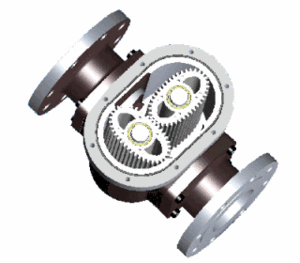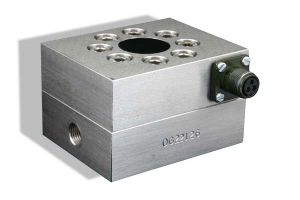Gear Flow Meters
Gear Flow Meters rely on internal gears rotating as fluid passes through them. Gear flow meter is a positive displacement meter that uses two or more oblong gears configured to rotate at right angles to one another, forming a T shape. Such a meter has two sides, which can be called A and B. No fluid passes through the center of the meter, where the teeth of the two gears always mesh. On one side of the meter (A), the teeth of the gears close off the fluid flow because the elongated gear on side A is protruding into the measurement chamber, while on the other side of the meter (B), a cavity holds a fixed volume of fluid in a measurement chamber. As the fluid pushes the gears, it rotates them, allowing the fluid in the measurement chamber on side B to be released into the outlet port. Meanwhile, fluid entering the inlet port will be driven into the measurement chamber of side A, which is now open. The teeth on side B will now close off the fluid from entering side B. This cycle continues as the gears rotate and fluid is metered through alternating measurement chambers. Permanent magnets in the rotating gears can transmit a signal to an electric reed switch or current transducer for flow measurement.
Types
There are various types of gear meters named mostly for the shape of the internal components.
Oval Gear
Two rotating oval gears with synchronized teeth squeeze a finite amount of fluid through the meter for each revolution. With oval gear flow meters, two oval gears or rotors are mounted inside a cylinder. As the fluid flows through the cylinder, the pressure of the fluid causes the rotors to rotate. As flow rate increases, so does the rotational speed of the rotors.
Helical Gear
Helical gear flow meters get their name from the shape of their gears or rotors. These rotors resemble the shape of a helix, which is a spiral-shaped structure. As the fluid flows through the meter, it enters the compartments in the rotors, causing the rotors to rotate. Flowrate is calculated from the speed of rotation.

